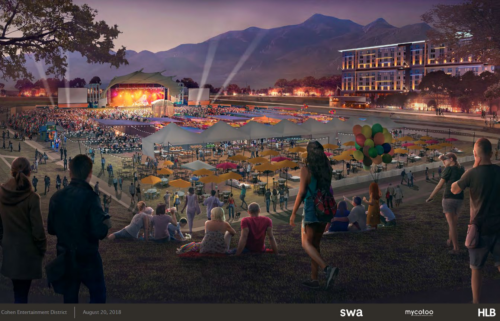Financial free fall dwindles south El Paso shops due to Covid-19 restrictions

EL PASO, Texas-- The area once referred to as the ‘Golden Horseshoe’ district in downtown El Paso is now marred by uncertainty brought on by policies meant to slow the spread of the pandemic.
The Department of Homeland Security last week announced it was once again extending the restrictions on non-essential travel at the border through April 21. While essential travel and trade remain in place, the policy in effect cuts the flow of shoppers from Juarez into the heart of downtown's shopping district.
That's been the case for an entire year already.
The busy, packed South El Paso Street with shoppers flocking in and out of businesses has turned quiet and business owners fear the financial recovery after the Covid-19 pandemic will not come.
"The amount of people that can come over is so limited, Covid being the excuse," said Tanny Berg, a co-founder of the El Paso Central Business Association. "The reality is, public policies have changed so dramatically that we've not allowed Mexican nationals to even come across and access restaurants and shops and families that may live on both sides of the border.”
Berg, a lifelong El Paso businessman, has a vested interest in the area as he owns multiple downtown properties.
“I've never seen vacancies on South El Paso street," he said. "All of a sudden there are vacancies. On the street parking, I had no problem finding a parking place. The reality is there was never a parking ability downtown... there's more parking than we need and that's sad, that is a sign to us that this is a distress zone,” Berg said.
The U.S. and Mexico first implemented the travel restrictions along the border on March 21st, 2020 as Covid-19 was starting to spread. Since then, the countries have renewed the restrictions monthly. That has led to empty streets and, for merchants, a bottom line that isn’t being met.
CBP officials tell ABC-7 border crossings are down dramatically. The number of cars crossing through all ports of entry in El Paso has dropped by 32 percent compared to a year ago. Pedestrian crossings are down even lower, plunging below 45 percent.
Downtown business owners tell ABC-7 the lack of foot traffic means dismal sales.
“We depend on the Mexican consumer for about 70 percent of our business or even more,” Said Sergio Gonzalez Salcido, whose business sits along South El Paso St. “If the restrictions are not lifted soon, if they don't open the bridge, 30 percent of retailers here will go out of business,” Gonzalez Salcido said.
Businesses have laid off many employees. Karla Leon is one of the lucky ones still holding on to a job as a sales associate in the Golden Horseshoe area. The 19-year-old lives in Juarez but is able to cross into the U.S. because she's an American citizen. The ability to earn dollars, rather than pesos has helped her family, the 19-year-old said.
“I live with my grandparents in Ciudad Juarez, I help my mom, even my siblings. I help them with school expenses and supplies, so yes, I help a lot," said Leon.
Thousands depend on the business generated on South El Paso St.
The lack of customers is also impacting landlords who must decide whether to make deep cuts to the leases or look for new tenants who can afford the rent.
As the storefronts become dotted with "For Lease" signs, the corridor that was named one of 10 Great Streets in America in 2008 by the American Planning Association for its rich history, culture and architecture, is in danger of becoming something no one in the Borderland has seen there: a dead zone.
Even the recent public investment by the city of El Paso to spruce up the "gateway to El Paso" may not be able to help. In 2018, it injected $6.4 million to its "Paseo de las Luces" project along South El Paso Street, from the base of the international bridge to the Plaza Theatre. The funds were used to build signature arches to frame the district, enhance the sidewalks and add strings of lights floating above the street.
The beautification project now lacks foot traffic and the fear is that shoppers will not return even after border restrictions are lifted.
"Will they come back? I mean, now they have learned that there are options in Mexico. Is there a need for the type of business they had a year ago, two years ago? Are they going to reconcile to go back to the businesses they've supported 50, 100 years when their shopping pattern has changed and they have discovered the Costco and Sam's that exists in Juarez?" Berg questioned. "That would be catastrophic for El Paso business."
This story was produced as part of the Puente News Collaborative, a binational partnership of news organizations in Ciudad Juárez and El Paso.
Other stories on this series:
As Covid-19 ravaged the border, U.S. and Mexico did little to work together


